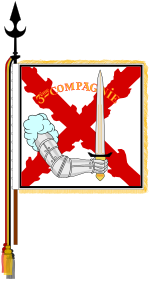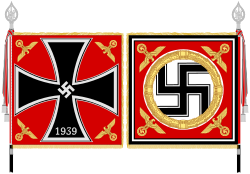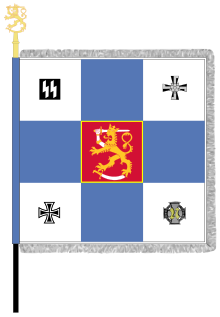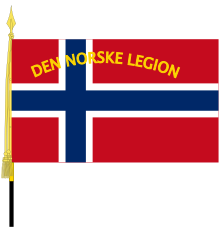Troop flag (Waffen-SS)
At the beginning of the Second World War , the units of the SS disposal troops , the Leibstandarte SS Adolf Hitler , the SS-Standarte Germania , the SS-Standarte Deutschland , and the SS-Standarte Der Führer were equipped with troop standards . In the course of the war, due to the general arrangement, no new troop flags were issued to military units, and thus also none to SS units. The only exceptions to this rule were flags and standards for units of the Waffen-SS and for foreign volunteers of the Waffen-SS .
Most of the Waffen-SS troop flags were captured by the Red Army in World War II and are now in the Central Museum of the Russian Armed Forces .
Units of the SS available troops
Leibstandarte SS Adolf Hitler
The Leibstandarte SS Adolf Hitler , LSSAH or LAH for short , was a unit of troops personally subordinate to Adolf Hitler . At the beginning of the Second World War, the Leibstandarte fought as a motorized infantry regiment under army command . The incorporation into the Waffen-SS in 1939 was followed by the expansion to a division (September 9, 1942 SS Panzer Grenadier Division; from October 1943 1st SS Panzer Division).
On August 15, 1938, the "LSSAH" was set up as a standing military unit and in September combined with the political readiness to form the " SS disposable troops ". As early as September 1933, during the party congress in Nuremberg, the Leibstandarte was presented with a troop standard that corresponded to the standard form generally used in the SS (and SA). It had a width of 70 cm and a height of 60 cm and was decorated on three sides with a black, white and red border made of wool threads. The total height of the standard was 2.30 meters. The name "Adolf Hitler" was in the name cartouche.
On September 3, 1940 - after France's military defeat - a new version of the standard was presented to the Leibstandarte. During a ceremony in Fort Alvensleben of the Metz fortress , Reichsführer SS Heinrich Himmler presented the new standard to Oberstgruppenführer Sepp Dietrich , the commander of the Leibstandarte.
The new standard differed from the first version mainly in the gold-plated name cartouche and a modified cloth. This was now square in shape with a side length of probably 70 cm. It was made of crimson silk. In the center of the standard was a white disk with a black swastika emblazoned on it. It was framed by a wreath of golden oak leaves. In each of the four corners there was a gold-colored NSDAP party eagle. All suspensions and decorations were made of gold. The back of the standard corresponded to the front.
Simultaneously with the introduction of a new regimental standard, the infantry units of the Leibstandarte received a special battalion flag. Its dimensions corresponded to the general army battalion flags and had a side length of 125 cm. The appearance of the cloth corresponded to that of the regimental standard. A large black iron cross was emblazoned on the left. A gold-colored NSDAP party eagle could be seen in each of the four corners.
The aluminum flag tip was lance-shaped and bore the stylized monogram “LAH” inside . A flag banderole was attached below the top of the flag, the appearance of which corresponded to the strap of the so-called " Order of Blood ". The ribbon ended in a silver-colored tassel.
A new standard was also presented for SS artillery units of the Leibstandarte. Its dimensions corresponded to those of the general army standards. ( see: Troop flag (Wehrmacht) ) The design of your cloth was adapted to the pattern of the infantry battalion flag.
SS-Standarten Deutschland, Germania and Der Führer
The standards of the three other units of the SS disposal force differed from those of the first version of the Leibstandarte only by the name in the name cartouche. While the SS Standard Germany received the standard at the Reich Party Congress in 1935 and the SS Standard Germania received it at the 1936 Party Congress, it was only presented to the SS Standard Der Fuehrer in 1938, also during the Party Congress in Nuremberg. In contrast to the Leibstandarte SS Adolf Hitler , however, these SS standards were not assigned any new standard models during the course of the war.
Foreign volunteer legions of the Waffen SS
Danish Legion
Within the first week after the German invasion of the Soviet Union, the Danish government announced the creation of a "Frikorps" to fight alongside the Wehrmacht on the Eastern Front . From the beginning the "Frikorps Danmark" was planned as part of the Waffen-SS . On July 19, 1941, the first 500 or so soldiers left Denmark and were transferred to Hamburg .
The troop flag of the Danish unit was probably presented to them at the time of departure from Denmark. It consisted of the Danish national flag (Dannebrog), to which the words "Frikorps Danmark" were added in white or yellow letters in the upper left corner. The flag had no border decorations and was attached to a wooden flagpole with 21 nails. The tip of the flag was in the shape of an ornamented, unfilled spearhead.
When the "Frikorps Danmark" in Bavaria was dissolved in April / May 1943 - the Legion suffered heavy losses - the survivors were transferred to a new Danish corps. This bore the name of the former "Frikorps" - commander Christian Frederik von Schalburg and was called "Schalburg Corps".
The troop flag of the "Schalburg Corps" was structured simply: It consisted of a black basic field (the dimensions are unknown) in the center of which there was a large, white swastika. Its thighs were shown in a curved shape so that the swastika fit into a circular outline. In the upper left corner was the national coat of arms of Denmark, consisting of a yellow shield (without a crown) on which there were three blue, crowned lions. Nine red hearts were scattered across the yellow sign.
Estonian Legion
On 28 August 1942 the first anniversary of the occupation of the Estonian capital Tallinn by the German Wehrmacht, proclaimed the German Commissioner General of Estonia, Litzmann that volunteers are needed for a "Estonian Legion," the German troops during battles on the Eastern Front support should. Due to the high response, three battalions could soon be set up and relocated to the German training camp near Debica in Poland . These were “1. Estonian SS Volunteer Grenadier Regiment ”.
This regiment is known to have had a troop flag, which is still kept in the "Estonian Archives" in Lakewood , New Jersey , USA. The flag had two different sides. The reverse showed the Estonian national flag in the colors blue-black-white, in the center of which - slightly shifted upwards - was the Estonian national coat of arms. This was fringed on both sides with a branch of gold-colored oak leaves. The flag was decorated on three sides with a gold (or silver) colored border made of fringes. The flagpole ended with a simple, narrow, square spearhead. Below this point was a double flag cord, which had two tassels at the end. In contrast to other flags, this was not hanging freely, but was firmly connected to the flagpole along the length of the flagpole.
The front of the flag had a black base field. In the center of this field was an emblem to represent the Estonian Legion, an armored, angled arm with a drawn sword in its hand. Above the crook of the arm was the letter "E", which stood for "Estonia" and was found in a similar way on the collar tabs of the Estonian SS units. Left and right of the angled arm were the letters "E" and right "L", which stood for "Eesti Leegioni", ie "Estonian Legion". The central emblem was lined with green pine branches that were worked in silver. At the bottom of the flag were the words: “1. GREN.RÜGEMENT “(1st Grenadier Regiment).
Flemish Legion
When Hitler invaded the Soviet Union in June 1941 , many of the volunteers in the Northwest Regiment were ready to join a newly created " Flemish Legion " to fight on the Eastern Front . Originally this legion had a number of German names. So it was as Flanders Association , National Association Flanders , Battalion Flanders and finally in September 1941 as Flanders volunteers Legion called. On August 6, 1941, the first contingent of Flemish volunteers paraded through Brussels , where they received their troop flag at the Palais de Beaux-Arts .
The dimensions of this flag are not exactly recorded, although it was quite large. The flag was colored light yellow and showed in the center a black, upright running Lion of Flanders . The origin of this lion can be traced back to the year 1164. At that time it was on the shield of Philip d'Alsace , a count from Flanders who died in 1191. It is known that such a shield was carried during the Third Crusade in 1189.
The flag was bordered on three sides with a decoration of black and yellow fringes. At the top and bottom there were 18 black areas, while there were 16 at the "flying end".
The flag was attached to the bamboo pole with five white or light yellow loops, which were presumably individually nailed to the flagpole.
The top of the flagpole was shaped like a small halberd.
Finnish Legion
On October 15, 1941, one month after the Finnish SS Volunteer Battalion "Northeast" was renamed "Finnish Volunteer Battalion of the Waffen SS", this unit was equipped with a troop flag. This was handed over by the Finnish military attaché in Berlin, Colonel Walter Horn , in Groß Born . Horn was a member of the " Finnish Jäger Battalion " during the First World War .
The flag consisted of the Finnish national flag in a square shape, a light blue cross on a white background. In the center of the flag was a red, yellow-lined square on which the yellow-colored "Lion of Finland" was emblazoned. He walked upright, was crowned, and held a silver sword in his right front paw as he trampled the silver Russian " scimitar ". There was an emblem in the center of each of the four corners of the flag. At the top left there were silver SS runes that sat on a black field. The "Finnish Freedom Cross" was visible in the upper right corner. At the bottom right was the “Finnish Jäger Cross” of the Royal Prussian Reserve Jäger Battalion No. 27. The lower left corner showed a representation of the German Iron Cross . Three sides of the flag were decorated with silver-colored fringes. The fourth was attached to a black, polished flagpole with a gold-colored Finnish lion at the top, in the same way as in the center of the flag. It is not known whether the flag continued to be used by the Finnish Army after the battalion was disbanded in June 1943 .
Latvian Legion
The Latvian contribution to the fight on the Eastern Front consisted essentially of police battalions, which were upgraded to regiments in the course of the war. Soon after Latvia was liberated from Soviet control, the German military leadership began disarming the Latvian anti-Soviet partisan units and transferring the relatives to volunteer police units under German command. Originally intended for use on Latvian soil, at the beginning of the Soviet winter offensive in 1941/1942, these units were also relocated to the front for combat operations.
Latvian units carried a troop flag, which essentially consisted of the Latvian national flag , which was covered with two dark carmine and a white stripe in the middle. The flag was attached to a flagpole that ended in a simple, possibly gold-colored spearhead.
Norwegian Legion
On June 29, 1941, just one week after the German invasion of the Soviet Union, the Reich Commissioner for Norway, Josef Terboven , announced that the establishment of a "Norwegian Legion" was being prepared. Soon it was possible to put together a volunteer legion from two regiments, the Viken 1st Regiment , the Viking 7th Regiment and a large number of soldiers from the Norges SS , which was officially called the Volunteer Legion "Norway" . This unit, eventually comprising two battalions, had its first deployment on the Eastern Front in February 1942 . The first of the battalions was entitled "Viken" in memory of the original volunteers of the 1st Hird Regiment.
Further intensive recruiting efforts led in the summer of 1942 to the formation of two more companies, one consisting essentially of members of the Norwegian labor service and the other of members of the police. The police company under the command of Jonas Lie supplemented the Norwegian Legion near Leningrad in September 1942 .
In March 1943, the remnants of the Norwegian Legion, largely destroyed by great losses, were withdrawn from the front. It was finally officially dissolved on May 20, 1943.
A flag that could not be classified in more detail consisted of the Norwegian national flag , which showed the words "DEN NORSKE LEGION" attached to an arch. These were yellow and applied to the upper part of the cloth. Contemporary images suggest that the flag was originally an ordinary national flag, which was additionally equipped with the aforementioned inscription and a gold-colored flag banderole with two tassels. The shape of the flag tip was modeled on a gold-colored lance tip.
The flag of the 1st “Viken Battalion” of the Norwegian Legion showed an upright, gold-colored crowned lion on a red background, holding the gold-colored battle ax of Saint Olaf in his forepaws. As the former Norwegian king, he was the patron saint of the country and died in 1030. Below the lion were the words "VIKEN BATALJON" in gold-colored letters. The flying end of the flag was cut out in a V-shape. The back of the flag was slightly different from the front: it had the motto “Alt for Norge” (Everything for Norway) and the dates of five battles fought by Norwegian forces between 1808 and 1814. The tip of the flag was modeled on a simple lance, which was probably made of a gold-colored material. The size of the flag is not entirely clear, although it is believed to be about 70 cm high and 85 cm wide.
In September or early October 1942, the first of four police companies was equipped with a troop flag. This was given to her by Vidkun Quisling before she left for Germany. The flag consisted of a red cloth on which the words "POLITIKOMPANIET" and "DEN NORSKE LEGION" were applied in yellow. The central emblem of the flag consisted of a stylized eagle - probably modeled after the German eagle - which held the symbol of the "sun cross" in its claws. This cross was used in many variations of Quisling's " Nasjonal Samling " movement. The sun cross was bordered on both sides by two oak branches. The flag was lined on three sides by gold-colored fringes. The fourth side was attached to a wooden pole with 17 nails, the tip of which ended in the shape of a lance. Below this point was a gold-colored flag banderole with a total of two tassels.
It is certain that the second police company was also equipped with a flag, which differed from that of the first company only in the inscription "2 POLITIKOMPANIET". It is very likely that the third and fourth companies were also presented with flags of this type.
Walloon Legion
| Walloon Legion (overview) | |||
|---|---|---|---|

|

|

|

|
| First version 1941–1942 | Company flag from 1942 (H: 3rd company) | Pennant of the headquarters company from 1942 | Pennant of the staff brigade from 1942 |
The first 800 volunteers who served in the "Walloon Legion" left Brussels on August 8, 1941. Under the name of Walloon Infantry Battalion No. 373 - which, strictly speaking, was directly subordinate to the Wehrmacht - and during a last parade before the march After Poland, the unit was given a special troop flag under the command of Léon Degrelle . It was square in shape, had a black base color and had a side length of 110 cm. In the center of the flag was a red diagonal cross, which was supposed to represent a stylized version of the Burgundy cross . The choice of the colors of black and red was apparently influenced by the colors of the fascist Rex party , of which Degrelle was chairman. Its members wore black uniforms and dark red party badges. The party flag also showed these colors. In connection with the gold-colored fringe decoration, all three colors also matched the Belgian national flag . The 2 meter high flagpole, the tip of which was lance-shaped, was made of bamboo cane. A flag banderole in the national colors of Belgium, black, yellow and red, was attached below the top of the flag.
New flags and pennants were given to the unit on March 10, 1942. After the members of the battalion had been transferred to the Waffen-SS as SS Storm Brigade Wallonia on June 1, 1943 , these flags and pennants were retained. A total of eight company flags and two pennants, one each for the staff brigade and one for the staff company, were presented.
Although all eight company flags had been made individually, the only difference between them was the company number. Each flag was 70 cm high and 82 cm wide. It was of a white basic color and had a large, jagged diagonal cross in the center. In the lower part of the flag was an armored right arm protruding from a light blue storm cloud. The hand grasped an erect sword. Above the arm was the name of the company, written in gold letters and in an arch shape. The flag was bordered on three sides with a gold-colored fringe decoration. The flagpole was made of brown wood and ended at the top with a representation of a historical weapon. These weapon tips were designed very differently and showed, for example, lances and the most varied halberd shapes. Below the top of the flag there was a band in the Belgian national colors black, yellow and red. They were about 140 cm long and each ended in a tassel that corresponds to the color. The centrally attached red cross not only stood for the "Rexist Movement", but was also a symbol for a crossed pair of branches of a tree. Historically, it has been associated with Burgundy, whose patron saint was the apostle and martyr St. Andrew (St. Andrew's Cross ). The armored arm, cloud and sword were widely used as symbols in the 16th and 17th centuries, often as a representation of the avenging right arm of God.
The pennants for the staff brigade and the staff company were designed similarly. Their height was 110 cm with a maximum width of 150 cm. They were attached to a 230 cm high pennant pole with the tip of a medieval weapon at the end. Both pennants were probably made of white silk and were decorated with a gold-colored, fringed border on the edge. A banner was woven into each of the red “Burgundy Cross”.
The pennant for the staff brigade contained a banner with the inscription Qui s'y Frotte s'y Pique , which translates as “If you rub yourself against it, you sting yourself ”. This motto was originally used by Belgians who were in the service of Empress Maria Theresa . An elaborately designed pennant sleeve was attached below the pennant tip. This was light blue in color and had the inscription LEGION VOLONTAIRE WALLONIE on one end and the words CAMPAGNE D URSS 1941–1942 on the other end .
The banner in the pennant for the headquarters company carried the inscription Dur & Pur Rex Vaincra , which translated means something like "Strong and pure, Rex will win". Furthermore, the general design of the pennant corresponded to that of the staff brigade. Only the inscription on the banner of the pennant banderole read CAMPAGNE D URSS 1943–1944 .
It can be seen on contemporary illustrations that the pennant tip showed different weapon symbols at different times. This leads to the conclusion that the pennant tip was removable and could be exchanged for other symbols at any time. Apparently most of these medieval weapon symbols were based on a collection that was in the museum at Porte de Hal in Brussels .
Legal notices
In Germany, the distribution and representation of symbols of National Socialism according to §§ 86 f. StGB punishable.
It is forbidden to distribute the above-mentioned markings, to use them in public or to use them in a meeting ( Section 86a, Paragraph 1, No. 1). Corresponding preparatory acts, namely manufacturing, keeping in stock and importing and exporting are also punishable ( Section 86a, Paragraph 1, No. 2).
Excluded from this are acts of civic education, the defense against unconstitutional efforts, art or science, research or teaching, reporting on current events or history or similar purposes ( § 86a Paragraph 3 in conjunction with § 86 para. 3 StGB).
See also: Using Unconstitutional Organization Marks
See also
literature
- Brian L. Davis: Flags of the Third Reich. Color plates by Malcolm McGregor. Volume 2: Waffen-SS. Osprey Military, London 1994, ISBN 1-85532-431-8 ( Men-at-Arms Series 274 The World Wars ).
Web links
- Verfassungsschutz.de: Right-wing extremism: Symbols, signs and prohibited organizations (PDF) ( Memento from January 16, 2015 in the Internet Archive )
- Criminal Code: Section 86a Use of symbols of unconstitutional organizations , on: dejure.org.
Individual evidence
- ↑ Andrea Kamp: Our Russians, our Germans. Pictures from the other 1800 to 2000 . Ch. Links Verlag, Berlin 2007, ISBN 978-3-86153-460-0 , p. 224-225 .
- ^ Film "Leibstandarte SS Adolf Hitler in Action"











